Maple Story theme by bestps3themes.com
Download: MapleStory.p3t

(5 backgrounds)
Redirect to:

The #1 spot for Playstation themes!
Terminator theme by Nigel Mansell
Download: Terminator.p3t

(6 backgrounds)
Terminator may refer to:
Prince of Persia: Warrior Within versionD theme by Deemy
Download: POPWarriorWithin_verD.p3t

(7 backgrounds)
P3T Unpacker v0.12
Copyright (c) 2007. Anoop Menon
This program unpacks Playstation 3 Theme files (.p3t) so that you can touch-up an existing theme to your likings or use a certain wallpaper from it (as many themes have multiple). But remember, if you use content from another theme and release it, be sure to give credit!
Download for Windows: p3textractor.zip
Instructions:
Download p3textractor.zip from above. Extract the files to a folder with a program such as WinZip or WinRAR. Now there are multiple ways to extract the theme.
The first way is to simply open the p3t file with p3textractor.exe. If you don’t know how to do this, right click the p3t file and select Open With. Alternatively, open the p3t file and it will ask you to select a program to open with. Click Browse and find p3textractor.exe from where you previously extracted it to. It will open CMD and extract the theme to extracted.[filename]. After that, all you need to do for any future p3t files is open them and it will extract.
The second way is very simple. Just drag the p3t file to p3textractor.exe. It will open CMD and extract the theme to extracted.[filename].
For the third way, first put the p3t file you want to extract into the same folder as p3textractor.exe. Open CMD and browse to the folder with p3extractor.exe. Enter the following:
p3textractor filename.p3t [destination path]Replace filename with the name of the p3t file, and replace [destination path] with the name of the folder you want the files to be extracted to. A destination path is not required. By default it will extract to extracted.filename.
Prince of Persia: The Sands of Time versionD theme by Deemy
Download: POPSandsOfTime_verD.p3t

(11 backgrounds)
P3T Unpacker v0.12
Copyright (c) 2007. Anoop Menon
This program unpacks Playstation 3 Theme files (.p3t) so that you can touch-up an existing theme to your likings or use a certain wallpaper from it (as many themes have multiple). But remember, if you use content from another theme and release it, be sure to give credit!
Download for Windows: p3textractor.zip
Instructions:
Download p3textractor.zip from above. Extract the files to a folder with a program such as WinZip or WinRAR. Now there are multiple ways to extract the theme.
The first way is to simply open the p3t file with p3textractor.exe. If you don’t know how to do this, right click the p3t file and select Open With. Alternatively, open the p3t file and it will ask you to select a program to open with. Click Browse and find p3textractor.exe from where you previously extracted it to. It will open CMD and extract the theme to extracted.[filename]. After that, all you need to do for any future p3t files is open them and it will extract.
The second way is very simple. Just drag the p3t file to p3textractor.exe. It will open CMD and extract the theme to extracted.[filename].
For the third way, first put the p3t file you want to extract into the same folder as p3textractor.exe. Open CMD and browse to the folder with p3extractor.exe. Enter the following:
p3textractor filename.p3t [destination path]Replace filename with the name of the p3t file, and replace [destination path] with the name of the folder you want the files to be extracted to. A destination path is not required. By default it will extract to extracted.filename.
Wizzin’ on the 360 theme by S
Download: WizzinOnThe360.p3t

(1 background)
P3T Unpacker v0.12
Copyright (c) 2007. Anoop Menon
This program unpacks Playstation 3 Theme files (.p3t) so that you can touch-up an existing theme to your likings or use a certain wallpaper from it (as many themes have multiple). But remember, if you use content from another theme and release it, be sure to give credit!
Download for Windows: p3textractor.zip
Instructions:
Download p3textractor.zip from above. Extract the files to a folder with a program such as WinZip or WinRAR. Now there are multiple ways to extract the theme.
The first way is to simply open the p3t file with p3textractor.exe. If you don’t know how to do this, right click the p3t file and select Open With. Alternatively, open the p3t file and it will ask you to select a program to open with. Click Browse and find p3textractor.exe from where you previously extracted it to. It will open CMD and extract the theme to extracted.[filename]. After that, all you need to do for any future p3t files is open them and it will extract.
The second way is very simple. Just drag the p3t file to p3textractor.exe. It will open CMD and extract the theme to extracted.[filename].
For the third way, first put the p3t file you want to extract into the same folder as p3textractor.exe. Open CMD and browse to the folder with p3extractor.exe. Enter the following:
p3textractor filename.p3t [destination path]Replace filename with the name of the p3t file, and replace [destination path] with the name of the folder you want the files to be extracted to. A destination path is not required. By default it will extract to extracted.filename.
Metal theme by Jabyaeye
Download: Metal_2.p3t
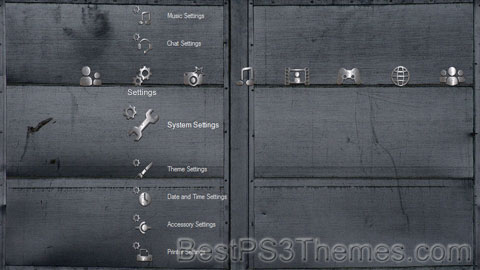
(5 backgrounds)
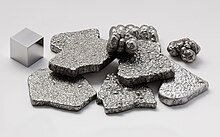

| Part of a series on the |
| Periodic table |
|---|
A metal (from Ancient Greek μέταλλον (métallon) 'mine, quarry, metal') is a material that when polished, or fractured, shows a lustrous appearance, and conducts electricity and heat relatively well. These properties are all associated with having electrons available at the Fermi level, as against nonmetallic materials which do not.[1]: Chpt 8 & 19 [2]: Chpt 7 & 8 Metals are typically ductile (can be drawn into wires) and malleable (they can be hammered into thin sheets).[3]
A metal may be a chemical element such as iron; an alloy such as stainless steel; or a molecular compound such as polymeric sulfur nitride.[4] The general science of metals is called metallurgy, a subtopic of materials science; aspects of the electronic and thermal properties are also within the scope of condensed matter physics and solid-state chemistry, it is a multidisciplinary topic.
A metal conducts electricity at a temperature of absolute zero,[5] which is a consequence of the states at the Fermi energy.[1][2] Many elements and compounds become metallic under high pressures, for example, iodine gradually becomes a metal at a pressure of between 40 and 170 thousand times atmospheric pressure. Sodium becomes a nonmetal at pressure of just under two million times atmospheric pressure, and at even higher pressures it is expected to become a metal again
When discussing the periodic table and some chemical properties the term metal is often used to denote those elements which in pure form and at standard conditions are metals in the sense of electrical conduction mentioned above. The related term metallic may also be used for types of dopant atoms or alloying elements.
In astronomy metal refers to all chemical elements in a star that are heavier than helium. In this sense the first four "metals" collecting in stellar cores through nucleosynthesis are carbon, nitrogen, oxygen, and neon. A star fuses lighter atoms, mostly hydrogen and helium, into heavier atoms over its lifetime. The metallicity of an astronomical object is the proportion of its matter made up of the heavier chemical elements.[6][7]
The strength and resilience of some metals has led to their frequent use in, for example, high-rise building and bridge construction, as well as most vehicles, many home appliances, tools, pipes, and railroad tracks. Precious metals were historically used as coinage, but in the modern era, coinage metals have extended to at least 23 of the chemical elements.[8] There is also extensive use of multi-element metals such as titanium nitride or degenerate semiconductors in the semiconductor industry.
The history of refined metals is thought to begin with the use of copper about 11,000 years ago. Gold, silver, iron (as meteoric iron), lead, and brass were likewise in use before the first known appearance of bronze in the fifth millennium BCE. Subsequent developments include the production of early forms of steel; the discovery of sodium—the first light metal—in 1809; the rise of modern alloy steels; and, since the end of World War II, the development of more sophisticated alloys.
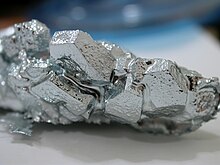
Most metals are shiny and lustrous, at least when polished, or fractured. Sheets of metal thicker than a few micrometres appear opaque, but gold leaf transmits green light. This is due to the electrons which reflect light.[1][2]
Although most elemental metals have higher densities than nonmetals,[9] is a wide variation in their densities, lithium being the least dense (0.534 g/cm3) and osmium (22.59 g/cm3) the most dense. (Some of the 6d transition metals are expected to be denser than osmium, but predictions on their densities vary widely in the literature, and in any case their known isotopes are too unstable for bulk production to be possible.) Magnesium, aluminium and titanium are light metals of significant commercial importance. Their respective densities of 1.7, 2.7, and 4.5 g/cm3 can be compared to those of the older structural metals, like iron at 7.9 and copper at 8.9 g/cm3. An iron ball would thus weigh about as much as three aluminum balls of equal volume.

Metals are typically malleable and ductile, deforming under stress without cleaving.[9] The nondirectional nature of metallic bonding contributes to the ductility of most metallic solids, where the Peierls stress is relatively low allowing for dislocation motion, and there are also many combinations of planes and directions for plastic deformation.[10] Due to their having close packed arrangements of atoms the Burgers vector of the dislocations are fairly small, which also means that the energy needed to produce one is small.[3][10] In contrast, in an ionic compound like table salt the Burgers vectors are much larger and the energy to move a dislocation is far higher.[3] Reversible elastic deformation in metals can be described well by Hooke's Law for the restoring forces, where the stress is linearly proportional to the strain.[11]
A temperature change may lead to the movement of structural defects in the metal such as grain boundaries, point vacancies, line and screw dislocations, stacking faults and twins in both crystalline and non-crystalline metals. Internal slip, creep, and metal fatigue may also ensue.[3][10]
The atoms of simple metallic substances are often in one of three common crystal structures, namely body-centered cubic (bcc), face-centered cubic (fcc), and hexagonal close-packed (hcp). In bcc, each atom is positioned at the center of a cube of eight others. In fcc and hcp, each atom is surrounded by twelve others, but the stacking of the layers differs. Some metals adopt different structures depending on the temperature.[12]
Many other metals with different elements have more complicated structures, such as rock-salt structure in titanium nitride or perovskite (structure) in some nickelates.[13]

The electronic structure of metals means they are relatively good conductors of electricity. The electrons all have different momenta, which average to zero when there is no external voltage. When a voltage is applied some move a little faster in a given direction, some a little slower so there is a nett drift velocity which leads to an electric current.[1][2] Quantum mechanics dictates that one can only have one electron in a given states, the Pauli exclusion principle.[14] Therefore there have to be empty states available at the highest occupied energies as sketched in the Figure. In a semiconductor like silicon or a nonmetal like strontium titanate there is an energy gap between the highest filled states of the electrons and the lowest unfilled. Consequently, semiconductors and nonmetals are relatively poor conductors, although they can carry some current when doped with elements that introduce additional energy states or at higher temperatures.[15]
The elemental metals have electrical conductivity values of from 6.9 × 103 S/cm for manganese to 6.3 × 105 S/cm for silver. In contrast, a semiconducting metalloid such as boron has an electrical conductivity 1.5 × 10−6 S/cm. With one exception, metallic elements reduce their electrical conductivity when heated. Plutonium increases its electrical conductivity when heated in the temperature range of around −175 to +125 °C, with anomalously large thermal expansion coefficient and a phase change from monoclinic to face-centered cubic near 100 °C.[16]
Metals are relatively good conductors of heat. At higher temperatures they can occupy slightly higher energy levels which are given by Fermi–Dirac statistics.[2][15] These have slightly higher momenta (kinetic energy) so can pass on thermal energy.
The contribution of a metal's electrons to its heat capacity and thermal conductivity, and the electrical conductivity of the metal itself can be approximately calculated from the free electron model.[2] However, this does not take into account the detailed structure of the metal's ion lattice. Taking into account the positive potential caused by the arrangement of the ion cores enables consideration of the electronic band structure and binding energy of a metal. Various models are applicable, the simplest being the nearly free electron model.[2] Modern methods such as density functional theory are typically used.
The elements which form metals usually form cations through electron loss.[9] Most will react with oxygen in the air to form oxides over various timescales (potassium burns in seconds while iron rusts over years) which depend upon whether the native oxide forms a passivation layer that acts as a
Space theme by Jabyaeye Download: Space_2.p3t
Space is a three-dimensional continuum containing positions and directions.[1] In classical physics, physical space is often conceived in three linear dimensions. Modern physicists usually consider it, with time, to be part of a boundless four-dimensional continuum known as spacetime.[2] The concept of space is considered to be of fundamental importance to an understanding of the physical universe. However, disagreement continues between philosophers over whether it is itself an entity, a relationship between entities, or part of a conceptual framework.
In the 19th and 20th centuries mathematicians began to examine geometries that are non-Euclidean, in which space is conceived as curved, rather than flat, as in the Euclidean space. According to Albert Einstein's theory of general relativity, space around gravitational fields deviates from Euclidean space.[3] Experimental tests of general relativity have confirmed that non-Euclidean geometries provide a better model for the shape of space.
Debates concerning the nature, essence and the mode of existence of space date back to antiquity; namely, to treatises like the Timaeus of Plato, or Socrates in his reflections on what the Greeks called khôra (i.e. "space"), or in the Physics of Aristotle (Book IV, Delta) in the definition of topos (i.e. place), or in the later "geometrical conception of place" as "space qua extension" in the Discourse on Place (Qawl fi al-Makan) of the 11th-century Arab polymath Alhazen.[4] Many of these classical philosophical questions were discussed in the Renaissance and then reformulated in the 17th century, particularly during the early development of classical mechanics.
Isaac Newton viewed space as absolute, existing permanently and independently of whether there was any matter in the.[5] In contrast, other natural philosophers, notably Gottfried Leibniz, thought that space was in fact a collection of relations between objects, given by their distance and direction from one another. In the 18th century, the philosopher and theologian George Berkeley attempted to refute the "visibility of spatial depth" in his Essay Towards a New Theory of Vision. Later, the metaphysician Immanuel Kant said that the concepts of space and time are not empirical ones derived from experiences of the outside world—they are elements of an already given systematic framework that humans possess and use to structure all experiences. Kant referred to the experience of "space" in his Critique of Pure Reason as being a subjective "pure a priori form of intuition".
Galilean and Cartesian theories about space, matter, and motion are at the foundation of the Scientific Revolution, which is understood to have culminated with the publication of Newton's Principia Mathematica in 1687.[6] Newton's theories about space and time helped him explain the movement of objects. While his theory of space is considered the most influential in physics, it emerged from his predecessors' ideas about the same.[7]
As one of the pioneers of modern science, Galileo revised the established Aristotelian and Ptolemaic ideas about a geocentric cosmos. He backed the Copernican theory that the universe was heliocentric, with a stationary Sun at the center and the planets—including the Earth—revolving around the Sun. If the Earth moved, the Aristotelian belief that its natural tendency was to remain at rest was in question. Galileo wanted to prove instead that the Sun moved around its axis, that motion was as natural to an object as the state of rest. In other words, for Galileo, celestial bodies, including the Earth, were naturally inclined to move in circles. This view displaced another Aristotelian idea—that all objects gravitated towards their designated natural place-of-belonging.[8]
Descartes set out to replace the Aristotelian worldview with a theory about space and motion as determined by natural laws. In other words, he sought a metaphysical foundation or a mechanical explanation for his theories about matter and motion. Cartesian space was Euclidean in structure—infinite, uniform and flat.[9] It was defined as that which contained matter; conversely, matter by definition had a spatial extension so that there was no such thing as empty space.[6]
The Cartesian notion of space is closely linked to his theories about the nature of the body, mind and matter. He is famously known for his "cogito ergo sum" (I think therefore I am), or the idea that we can only be certain of the fact that we can doubt, and therefore think and therefore exist. His theories belong to the rationalist tradition, which attributes knowledge about the world to our ability to think rather than to our experiences, as the empiricists believe.[10] He posited a clear distinction between the body and mind, which is referred to as the Cartesian dualism.
Following Galileo and Descartes, during the seventeenth century the philosophy of space and time revolved around the ideas of Gottfried Leibniz, a German philosopher–mathematician, and Isaac Newton, who set out two opposing theories of what space is. Rather than being an entity that independently exists over and above other matter, Leibniz held that space is no more than the collection of spatial relations between objects in the world: "space is that which results from places taken together".[11] Unoccupied regions are those that could have objects in them, and thus spatial relations with other places. For Leibniz, then, space was an idealised abstraction from the relations between individual entities or their possible locations and therefore could not be continuous but must be discrete.[12]
Space could be thought of in a similar way to the relations between family members. Although people in the family are related to one another, the relations do not exist independently of the people.[13]
Leibniz argued that space could not exist independently of objects in the world because that implies a difference between two universes exactly alike except for the location of the material world in each universe. But since there would be no observational way of telling these universes apart then, according to the identity of indiscernibles, there would be no real difference between them. According to the principle of sufficient reason, any theory of space that implied that there could be these two possible universes must therefore be wrong.[14]
Newton took space to be more than relations between material objects and based his position on observation and experimentation. For a relationist there can be no real difference between inertial motion, in which the object travels with constant velocity, and non-inertial motion, in which the velocity changes with time, since all spatial measurements are relative to other objects and their motions. But Newton argued that since non-inertial motion generates forces, it must be absolute.[15] He used the example of water in a spinning bucket to demonstrate his argument. Water in a bucket is hung from a rope and set to spin, starts with a flat surface. After a while, as the bucket continues to spin, the surface of the water becomes concave. If the bucket's spinning is stopped then the surface of the water remains concave as it continues to spin. The concave surface is therefore apparently not the result of relative motion between the bucket and the water.[16] Instead, Newton argued, it must be a result of non-inertial motion relative to space itself. For several centuries the bucket argument was considered decisive in showing that space must exist independently of matter.
In the eighteenth century the German philosopher Immanuel Kant published his theory of space as "a property of our mind" by which "we represent to ourselves objects as outside us, and all as in space" in the Critique of Pure Reason[17] On his view the nature of spatial predicates are "relations that only attach to the form of intuition alone, and thus to the subjective constitution of our mind, without which these predicates could not be attached to anything at all."[18] This develops his theory of knowledge in which knowledge about space itself can be both a priori and synthetic.[19]
According to Kant, knowledge about space is synthetic because any proposition about space cannot be true merely in virtue of the meaning of the terms contained in the proposition. In the counter-example, the proposition "all unmarried men are bachelors" is true by virtue of each term's meaning. Further, space is a priori because it is the form of our receptive abilities to receive information about the external world. For example, someone without sight can still perceive spatial attributes via touch, hearing, and smell. Knowledge of space itself is a priori because it belongs to the subjective constitution of our mind as the form or manner of our intuition of external objects.
Euclid's Elements contained five postulates that form the basis for Euclidean geometry. One of these, the parallel postulate, has been the subject of debate among mathematicians for many centuries. It states that on any plane on which there is a straight line L1 and a point P not on L1, there is exactly one straight line L2 on the plane that passes through the point P and is parallel to the straight line L1. Until the 19th century, few doubted the truth of the postulate; instead debate centered over whether it was necessary as an axiom, or whether it was a theory that could be derived from the other axioms.[20] Around 1830 though, the Hungarian János Bolyai and the Russian Nikolai Ivanovich Lobachevsky separately published treatises on a type of geometry that does not include the parallel postulate, called hyperbolic geometry. In this geometry, an infinite number of parallel lines pass through the point P. Consequently, the sum of angles in a triangle is less than 180° and the ratio of a circle's circumference to its diameter is greater than pi. In the 1850s, Bernhard Riemann developed an equivalent theory of elliptical geometry, in which no parallel lines pass through P. In this geometry, triangles have more than 180° and circles have a ratio of circumference-to-diameter that is less than pi.
Although there was a prevailing Kantian consensus at the time, once non-Euclidean geometries had been formalised, some began to wonder whether or not physical space is curved. Carl Friedrich Gauss, a German mathematician, was the first to consider an empirical investigation of the geometrical structure of space. He thought of making a test of the sum of the angles of an enormous stellar triangle, and there are reports that he actually carried out a test, on a small scale, by triangulating mountain tops in Germany.[21]
Henri Poincaré, a French mathematician and physicist of the late 19th century, introduced an important insight in which he attempted to demonstrate the futility of any attempt to discover which geometry applies to space by experiment.[22] He considered the predicament that would face scientists if they were confined to the surface of an imaginary large sphere with particular properties, known as a sphere-world. In this world, the temperature is taken to vary in such a way that all objects expand and contract in similar proportions in different places on the sphere. With a suitable falloff in temperature, if the scientists try to use measuring rods to determine the sum of the angles in a triangle, they can be deceived into thinking that they inhabit a plane, rather than a spherical surface.[23] In fact, the scientists cannot in principle determine whether they inhabit a plane or sphere and, Poincaré argued, the same is true for the debate over whether real space is Euclidean or not. For him, which geometry was used to describe space was a matter of convention.[24] Since Euclidean geometry is simpler than non-Euclidean geometry, he assumed the former would always be used to describe the 'true' geometry of the world.[25]
In 1905, Albert Einstein published his special theory of relativity, which led to the concept that space and time can be viewed as a single construct known as spacetime. In this theory, the speed of light in vacuum is the same for all observers—which has the result that two events that appear simultaneous to one particular observer will not be simultaneous to another observer if the observers are moving with respect to one another. Moreover, an observer will measure a moving clock to tick more slowly than one that is stationary with respect to them; and objects are measured to be shortened in the direction that they are moving with respect to the observer.
Subsequently, Einstein worked on a general theory of relativity, which is a theory of how gravity interacts with spacetime. Instead of viewing gravity as a force field acting in spacetime, Einstein suggested that it modifies the geometric structure of spacetime itself.[26] According to the general theory, time goes more slowly at places with lower gravitational potentials and rays of light bend in the presence of a gravitational field. Scientists have studied the behaviour of binary pulsars, confirming the predictions of Einstein's theories, and non-Euclidean geometry is usually used to describe spacetime.
In modern mathematics spaces are defined as sets with some added structure. They are typically topological spaces, in which a concept of neighbourhood is defined, frequently by means of a distance (metric spaces). The elements of a space are often called points, but they can have other names such as vectors in vector spaces and functions in function spaces.
Space #2
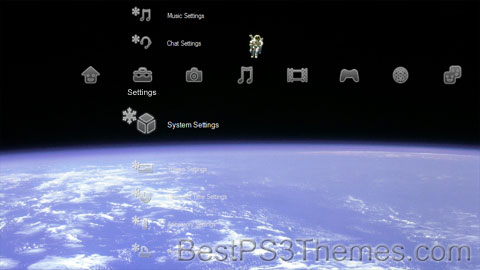
(1 background)

Philosophy of space[edit]
Galileo[edit]
René Descartes[edit]
Leibniz and Newton[edit]
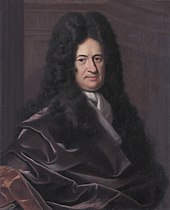
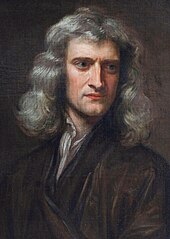
Kant[edit]

Non-Euclidean geometry[edit]

Type of geometry
Number of parallels
Sum of angles in a triangle
Ratio of circumference to diameter of circle
Measure of curvature
Hyperbolic
Infinite
< 180°
> π
< 0
Euclidean
1
180°
π
0
Elliptical
0
> 180°
< π
> 0
Gauss and Poincaré[edit]


Einstein[edit]
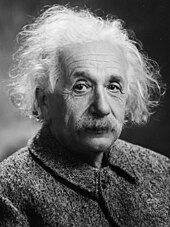
Mathematics[edit]
Physics[edit]
Part of a series on Classical mechanics